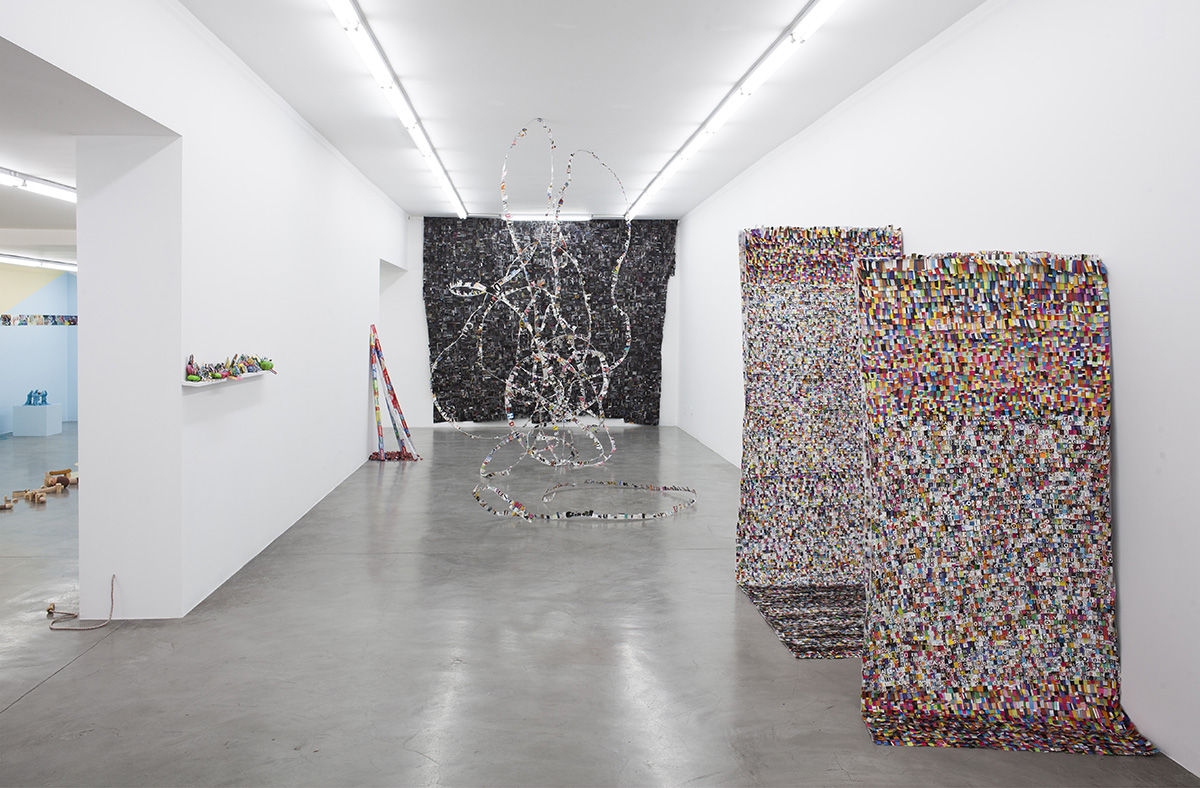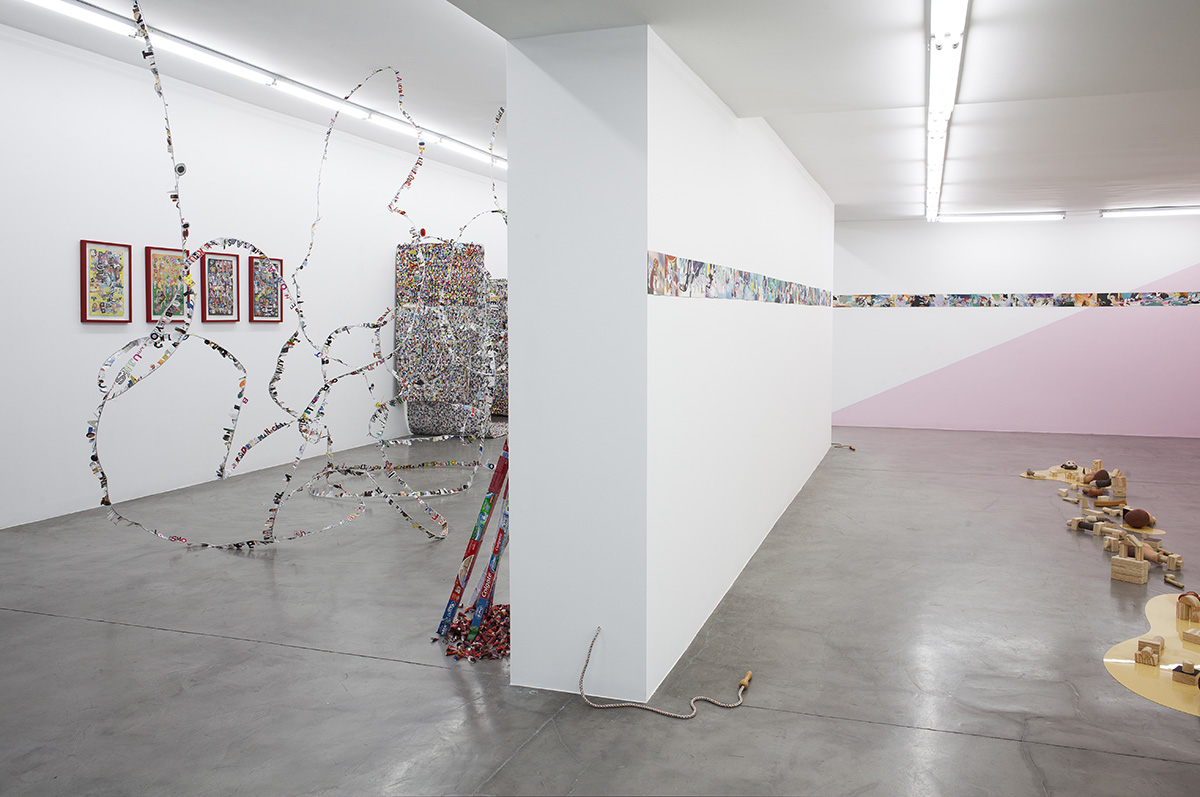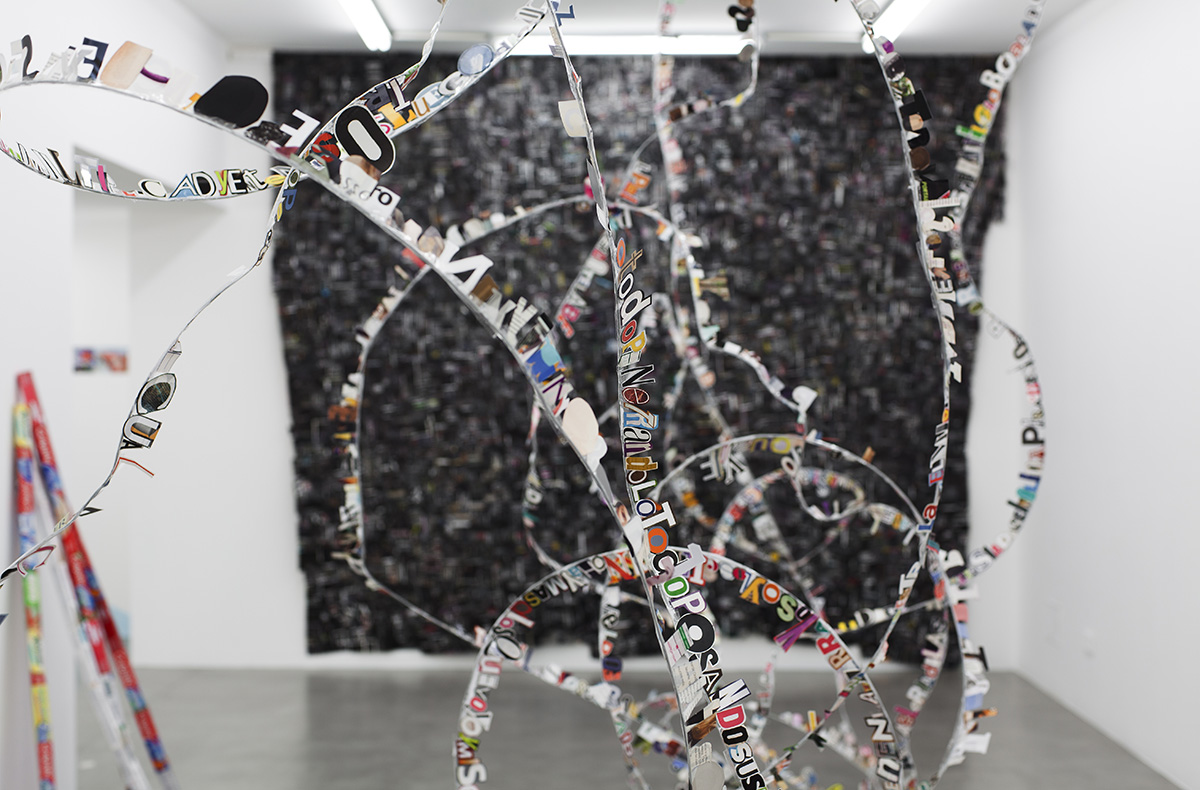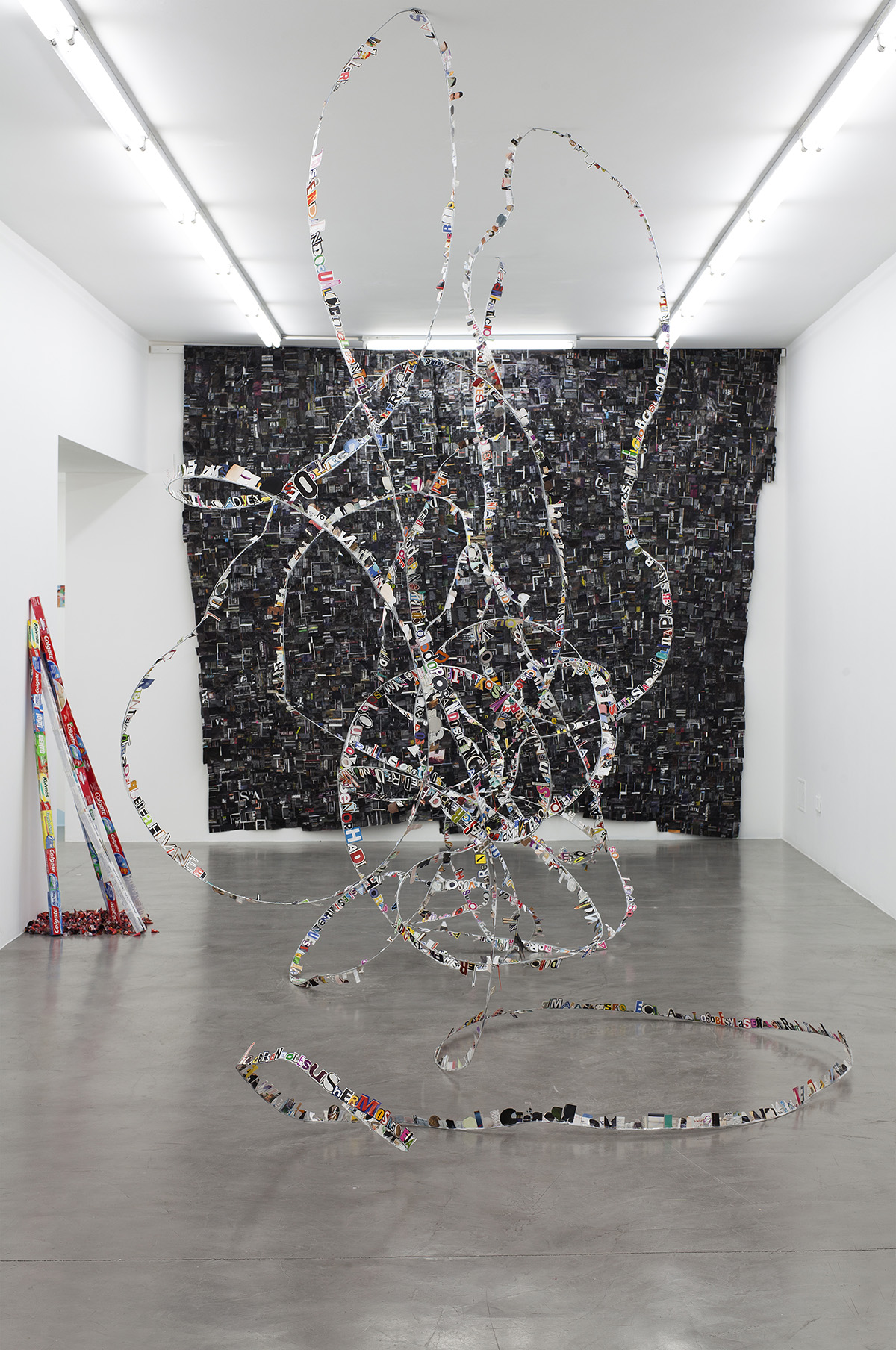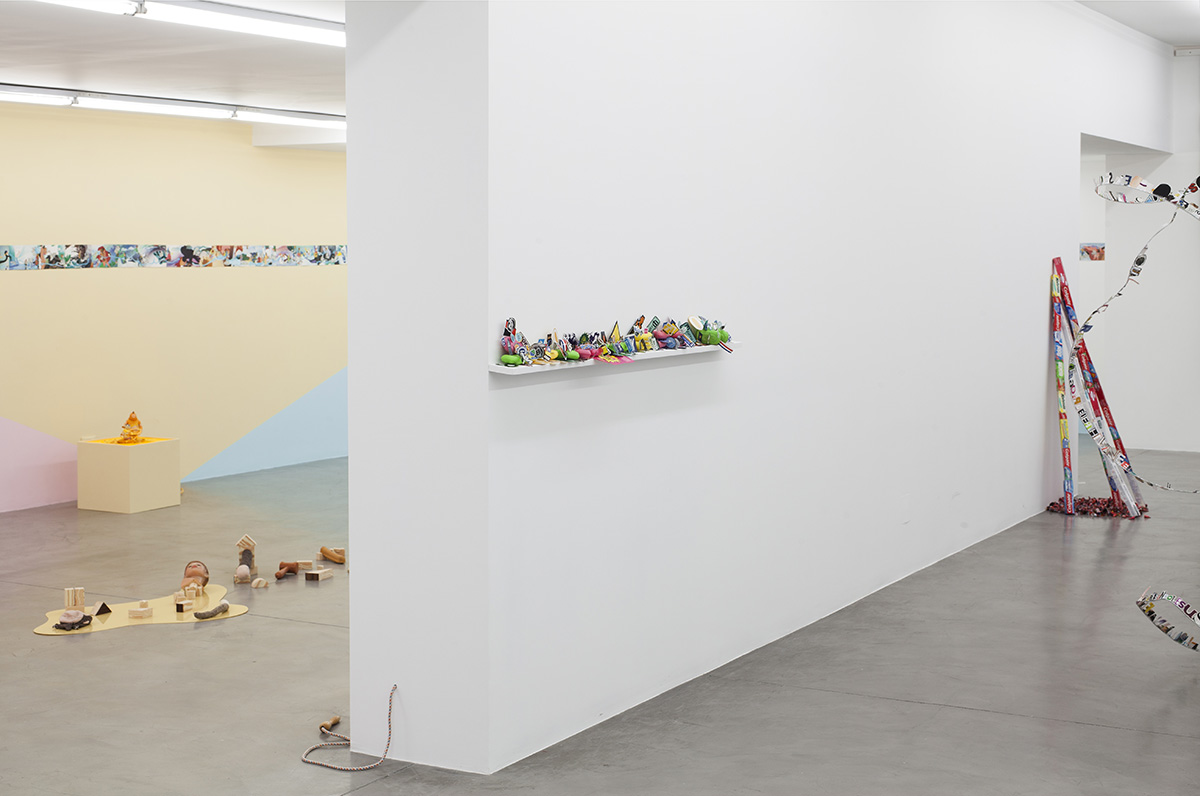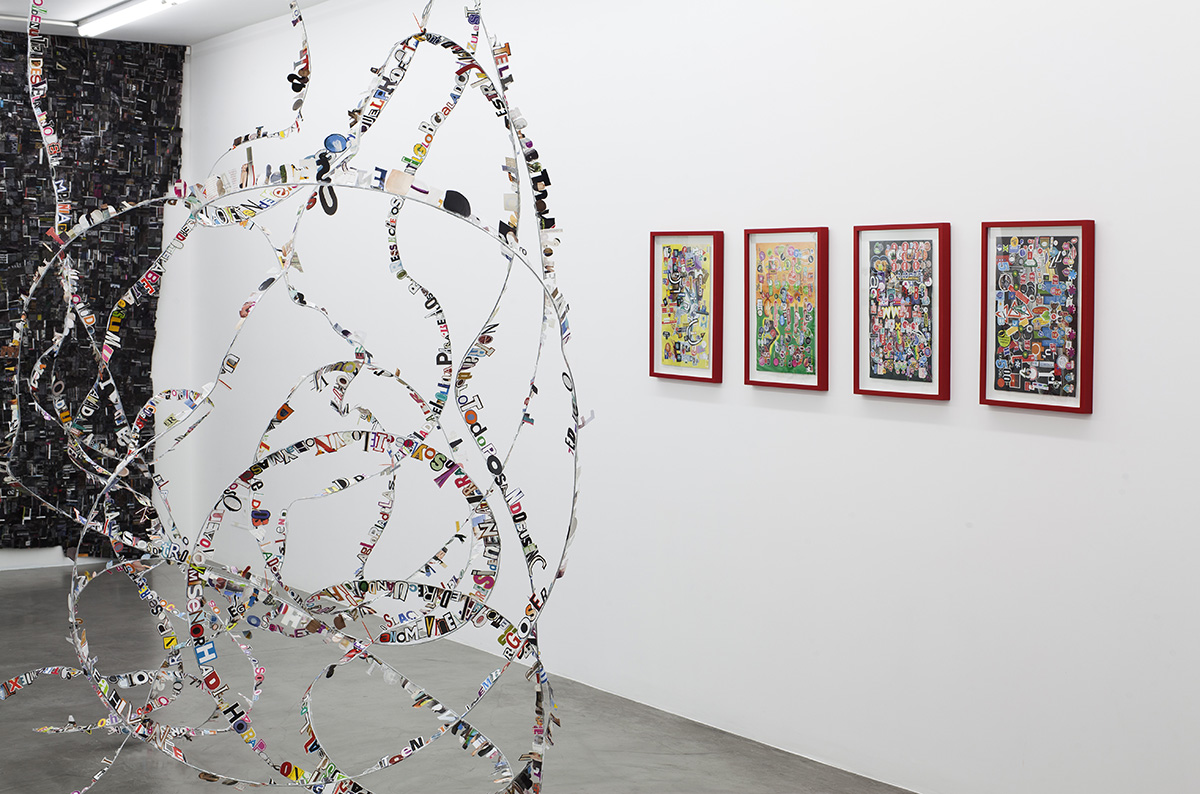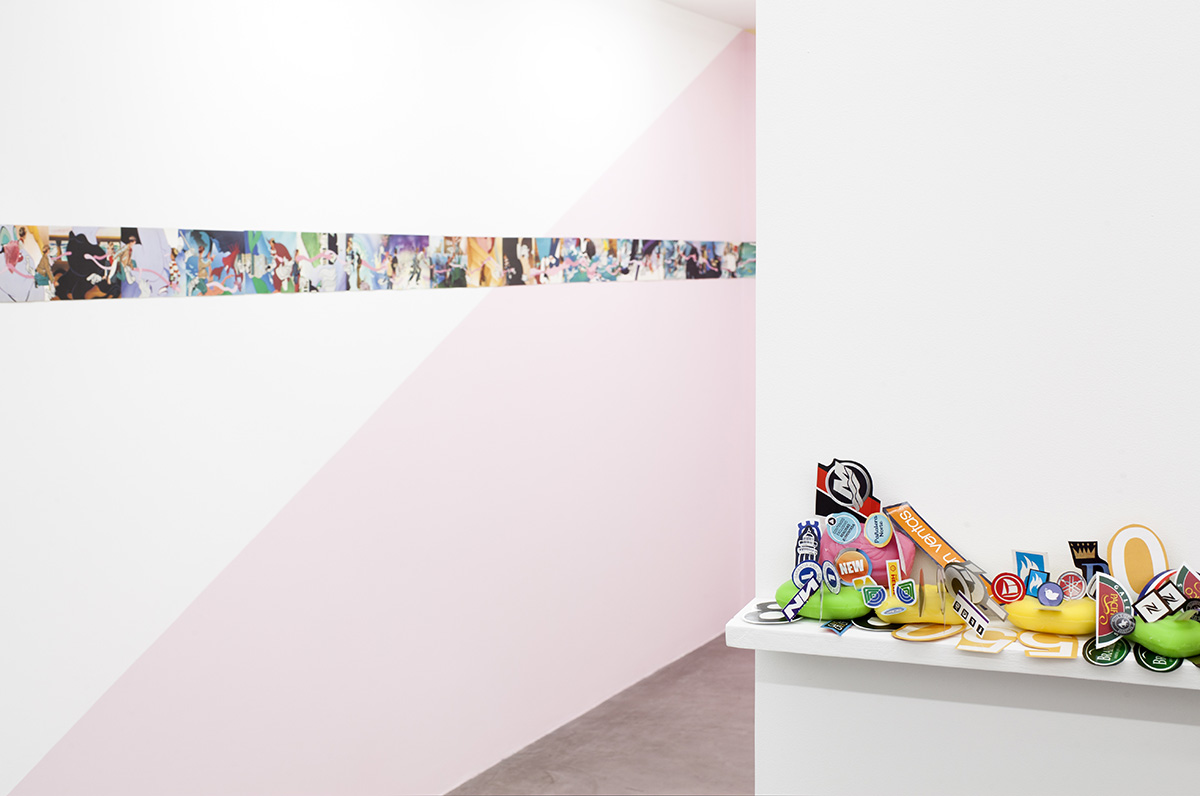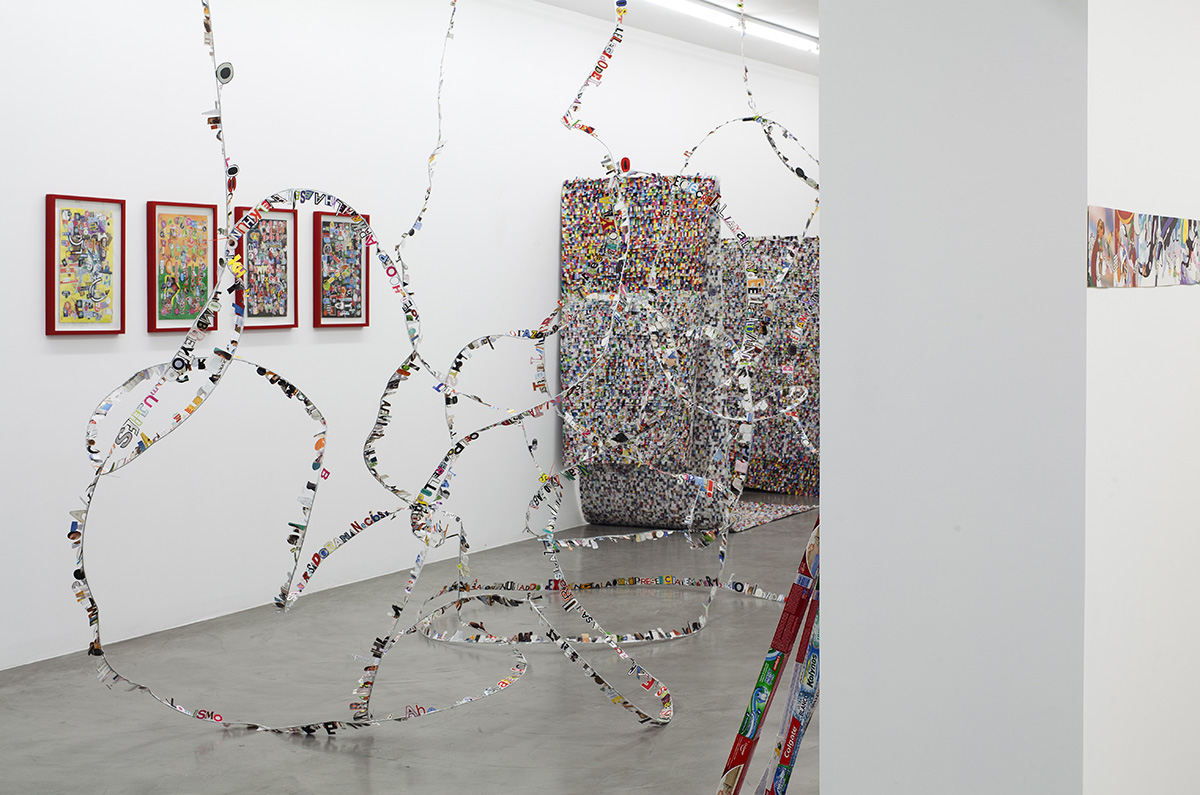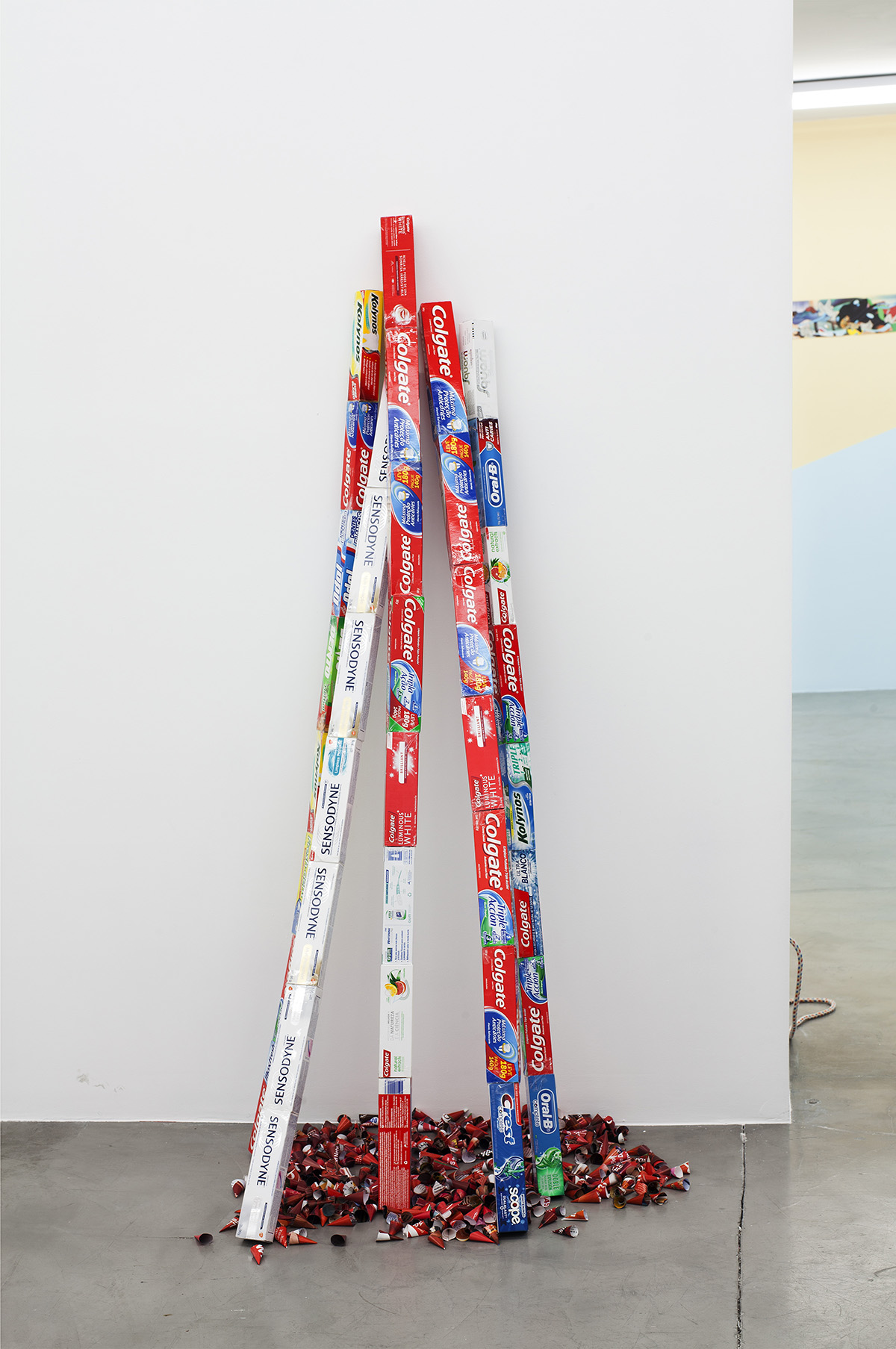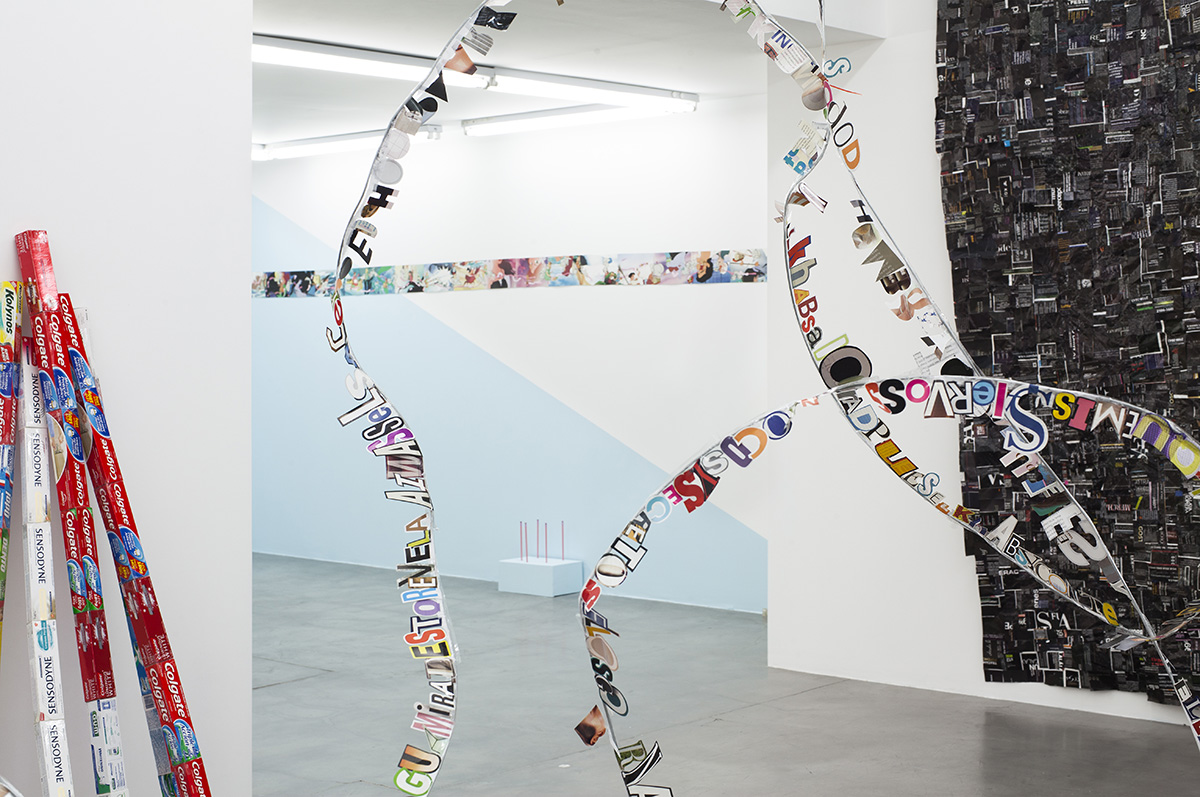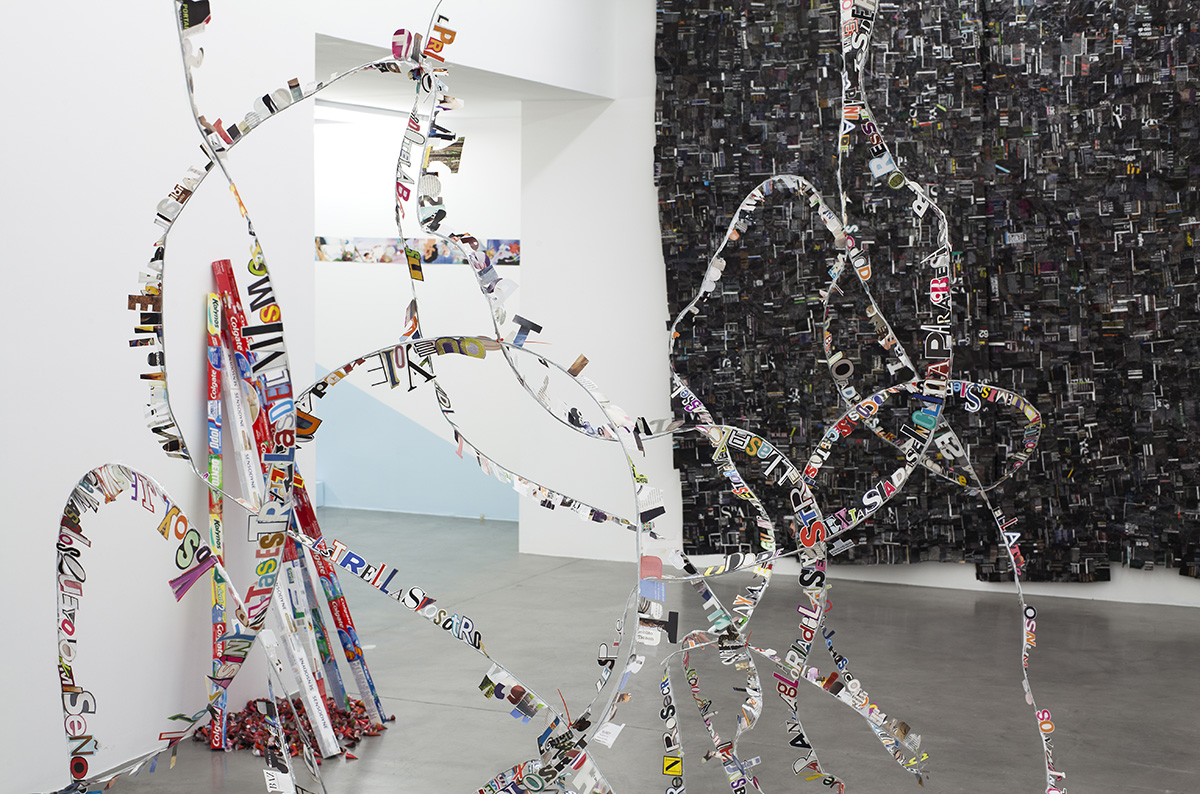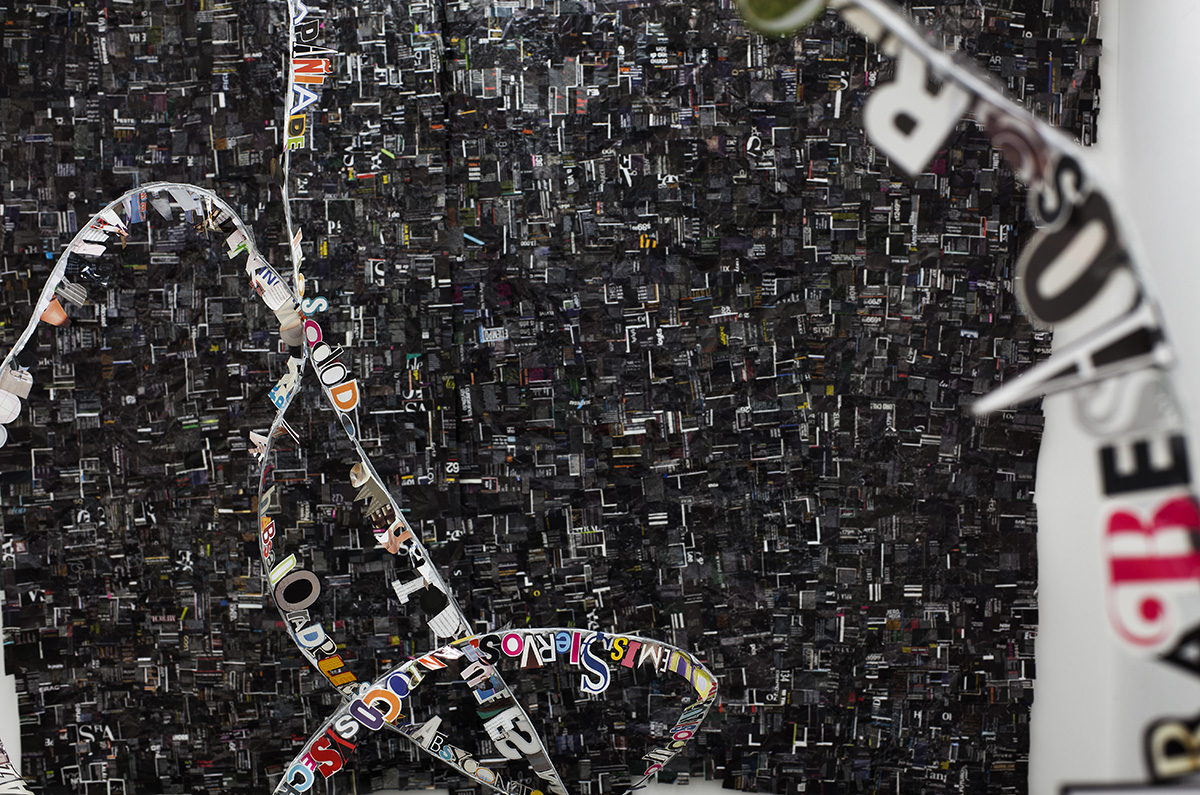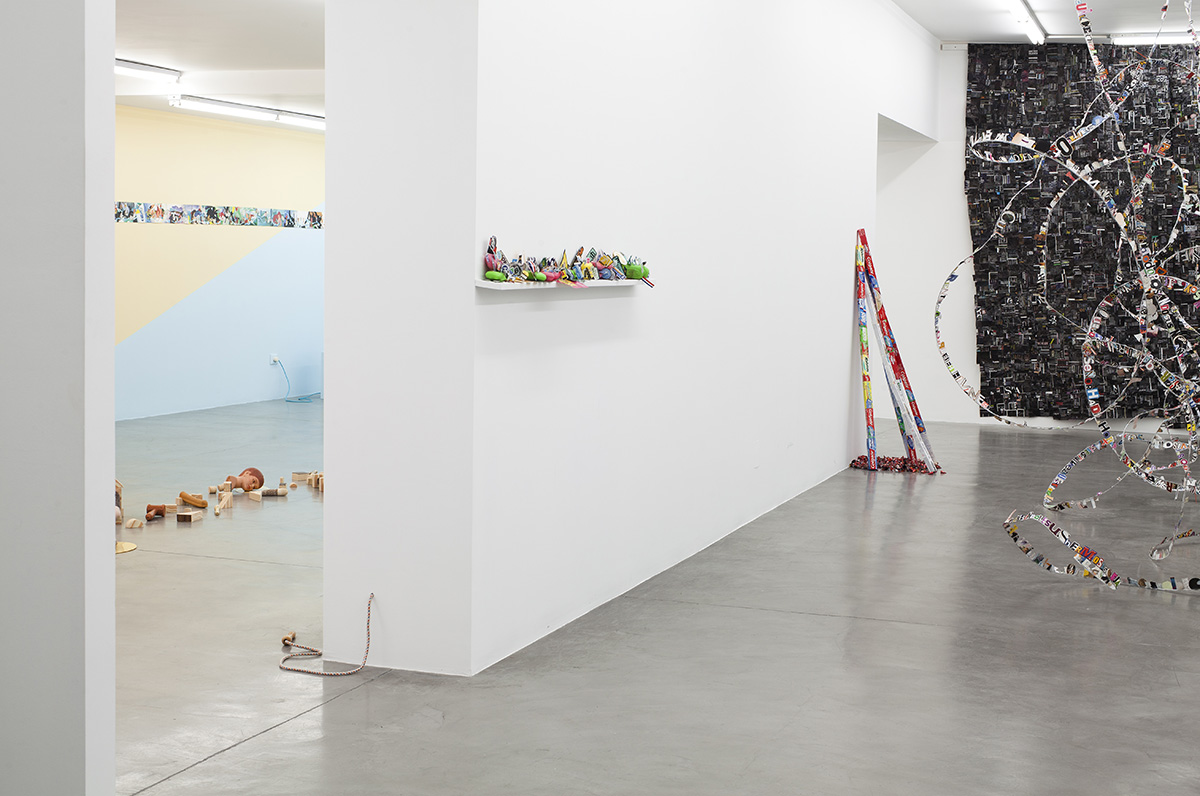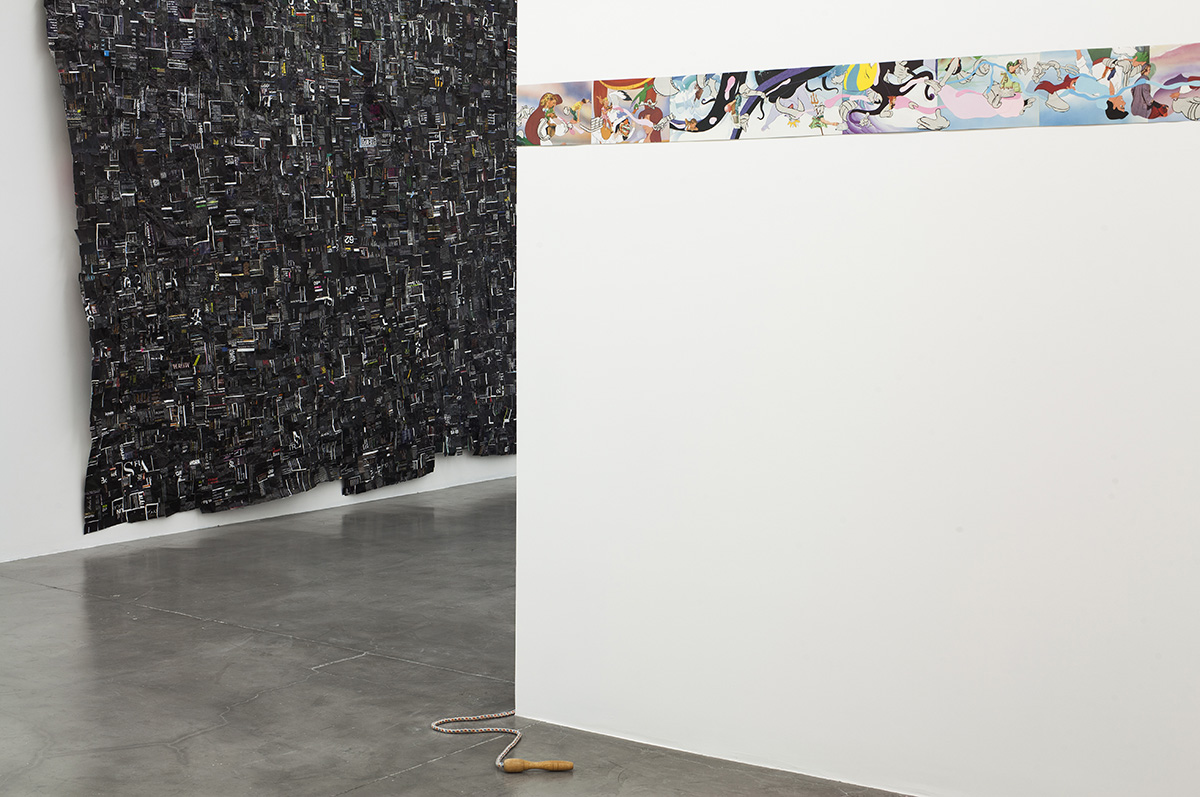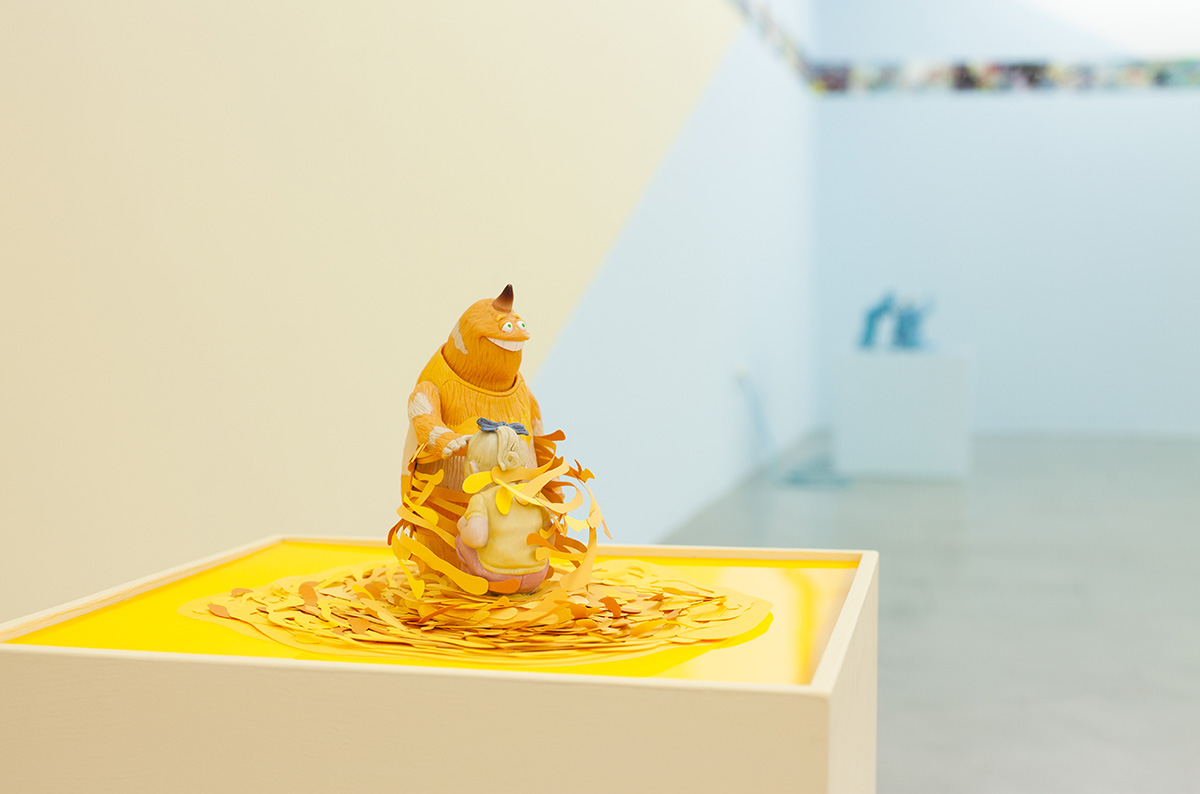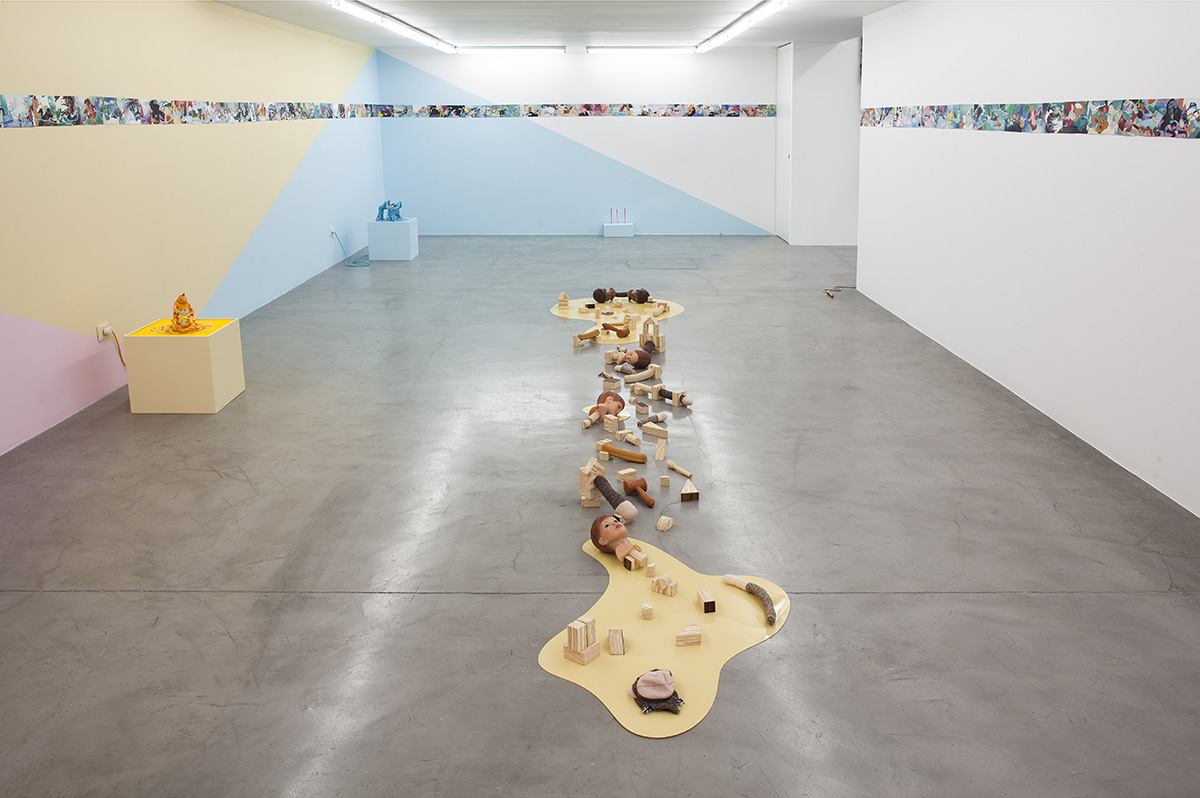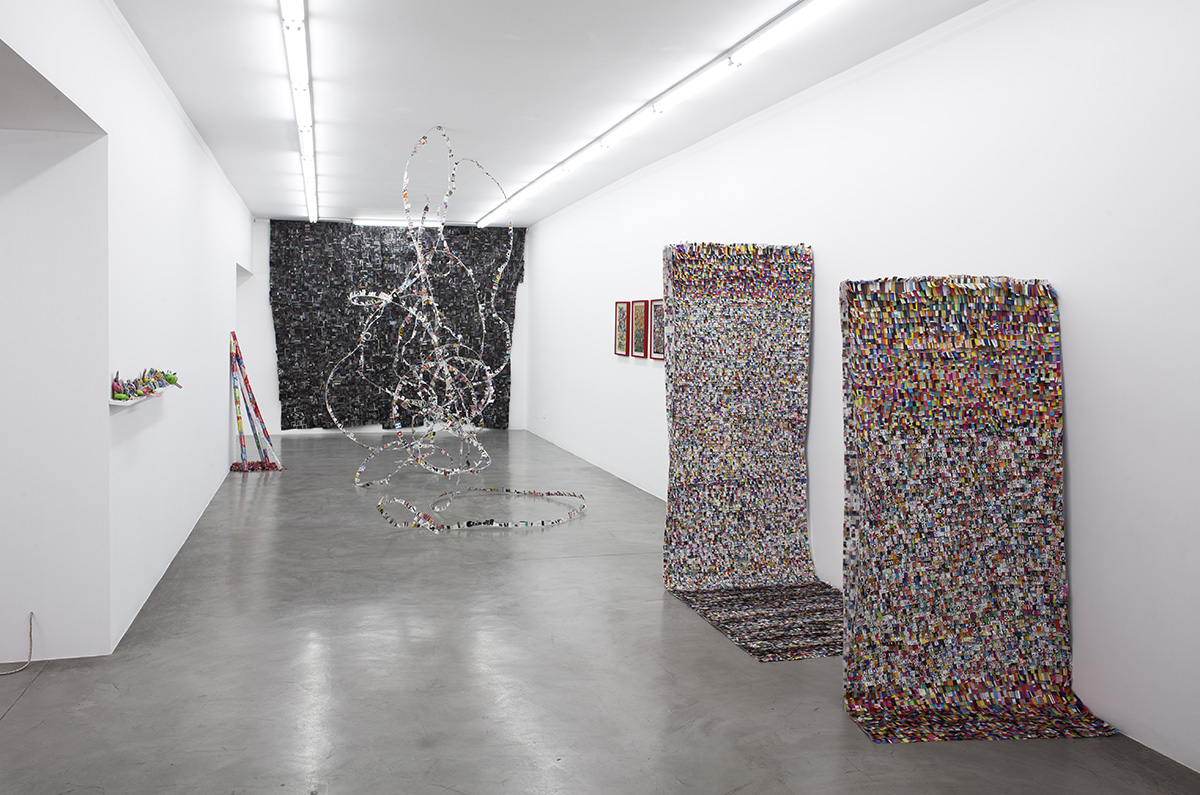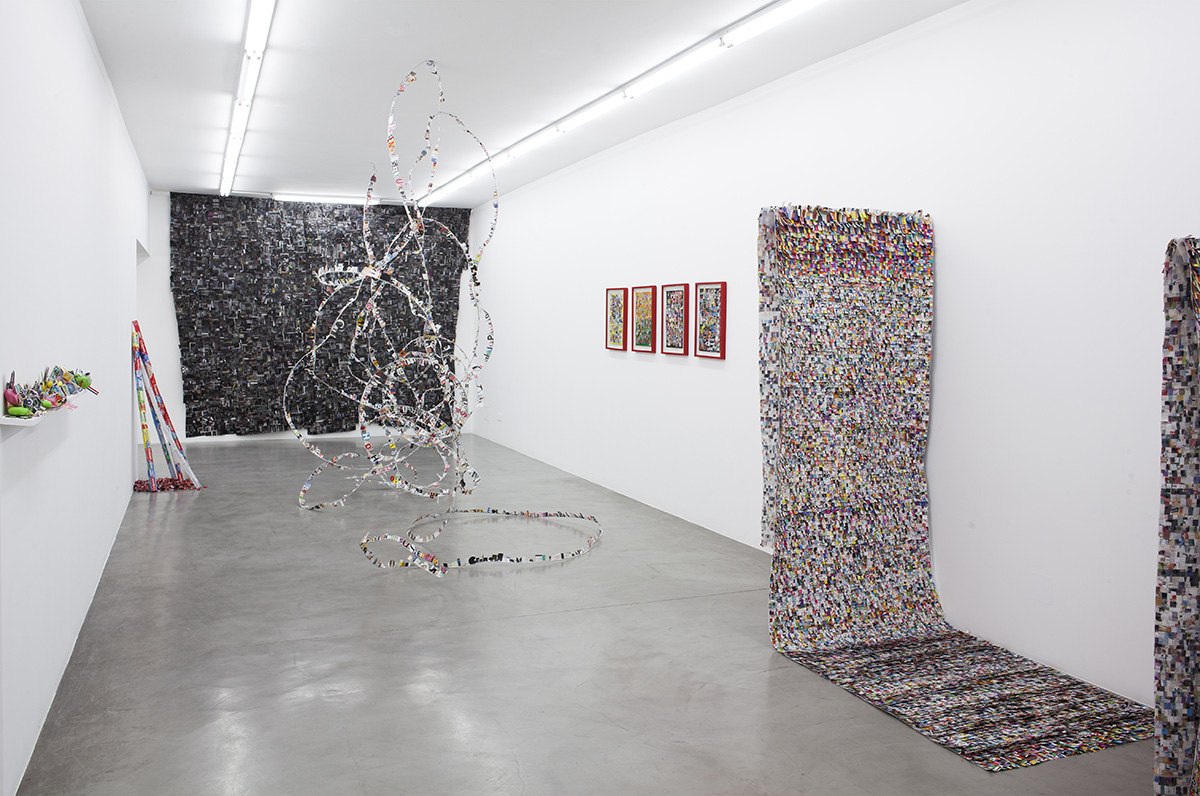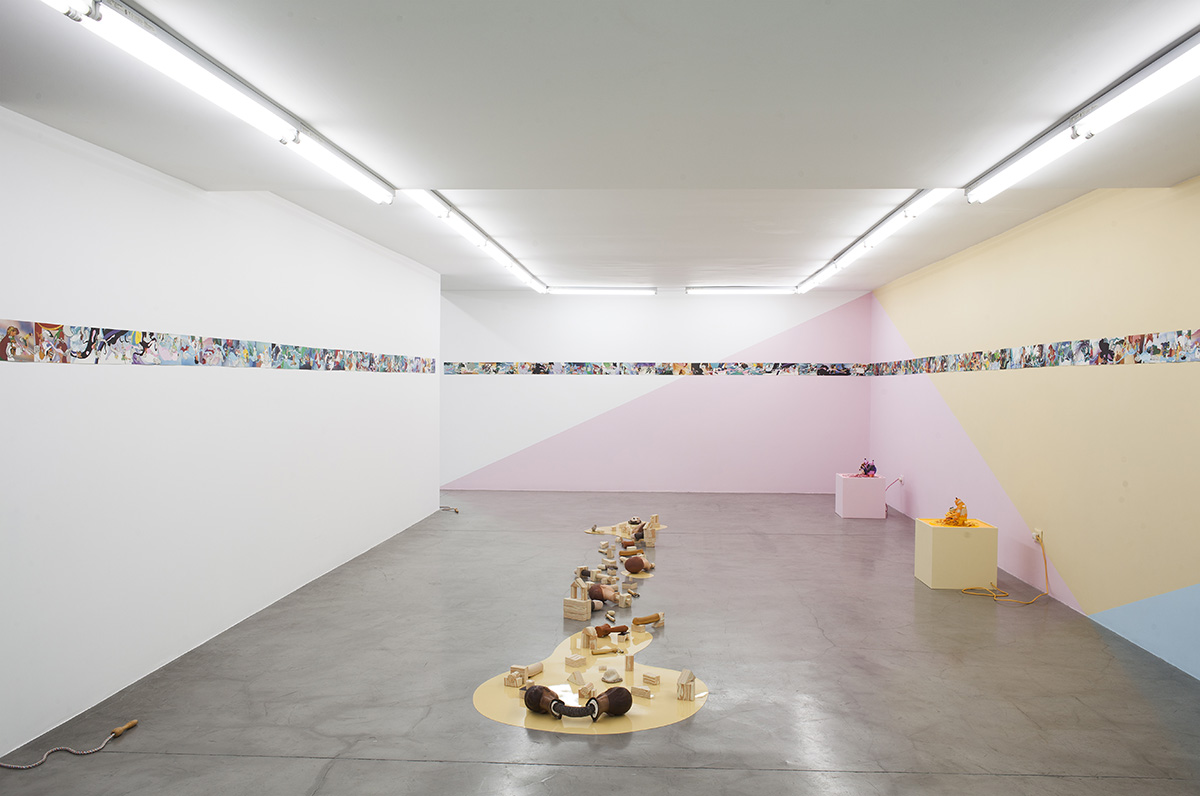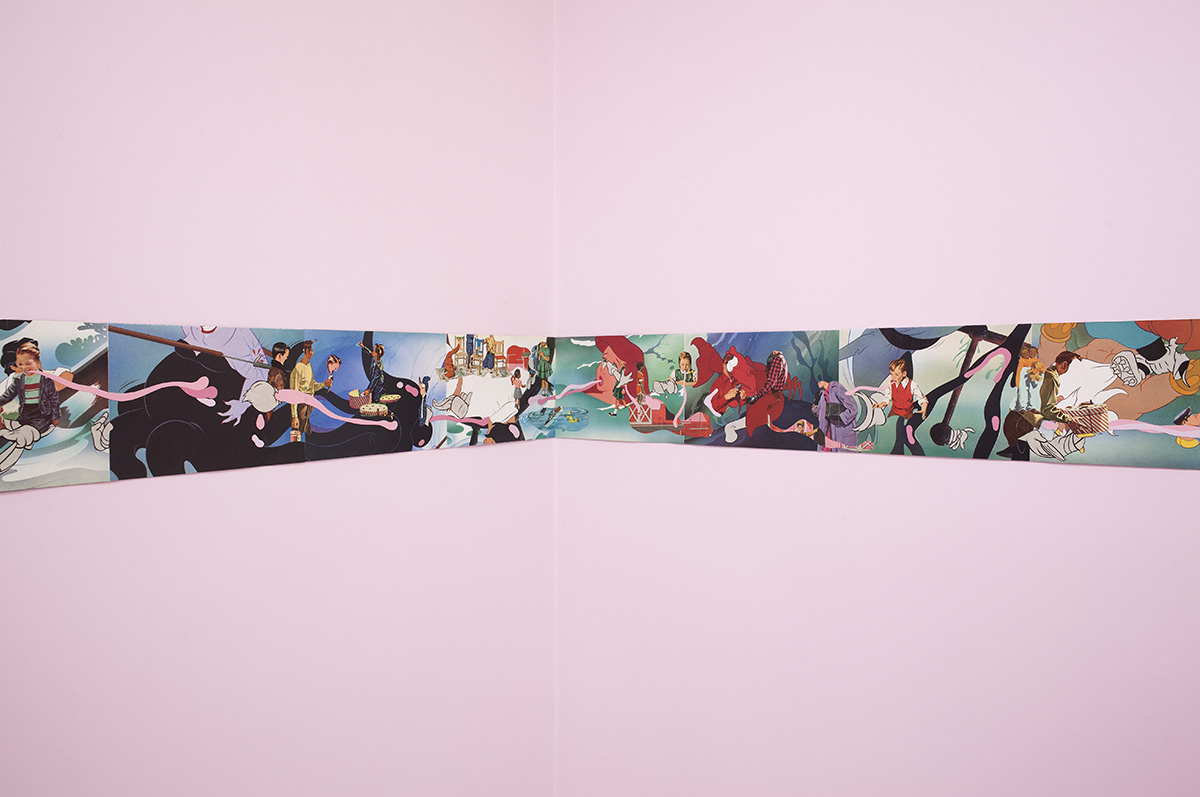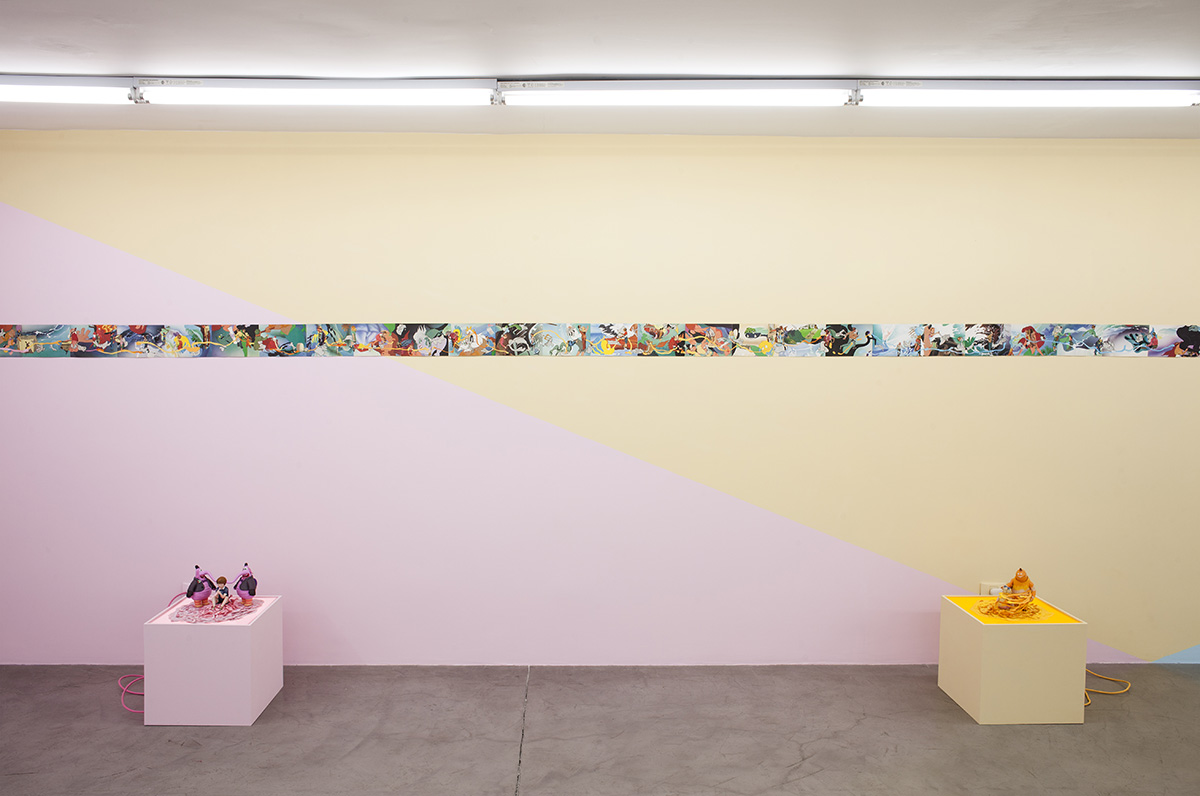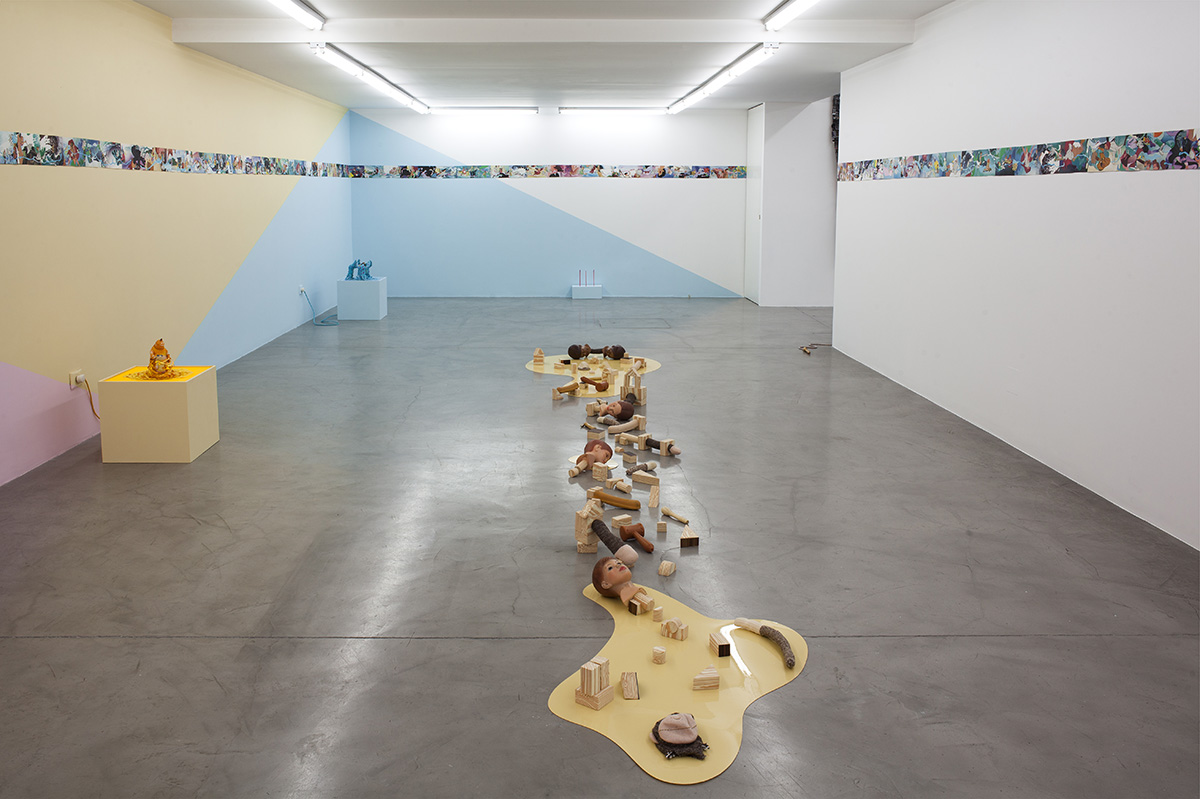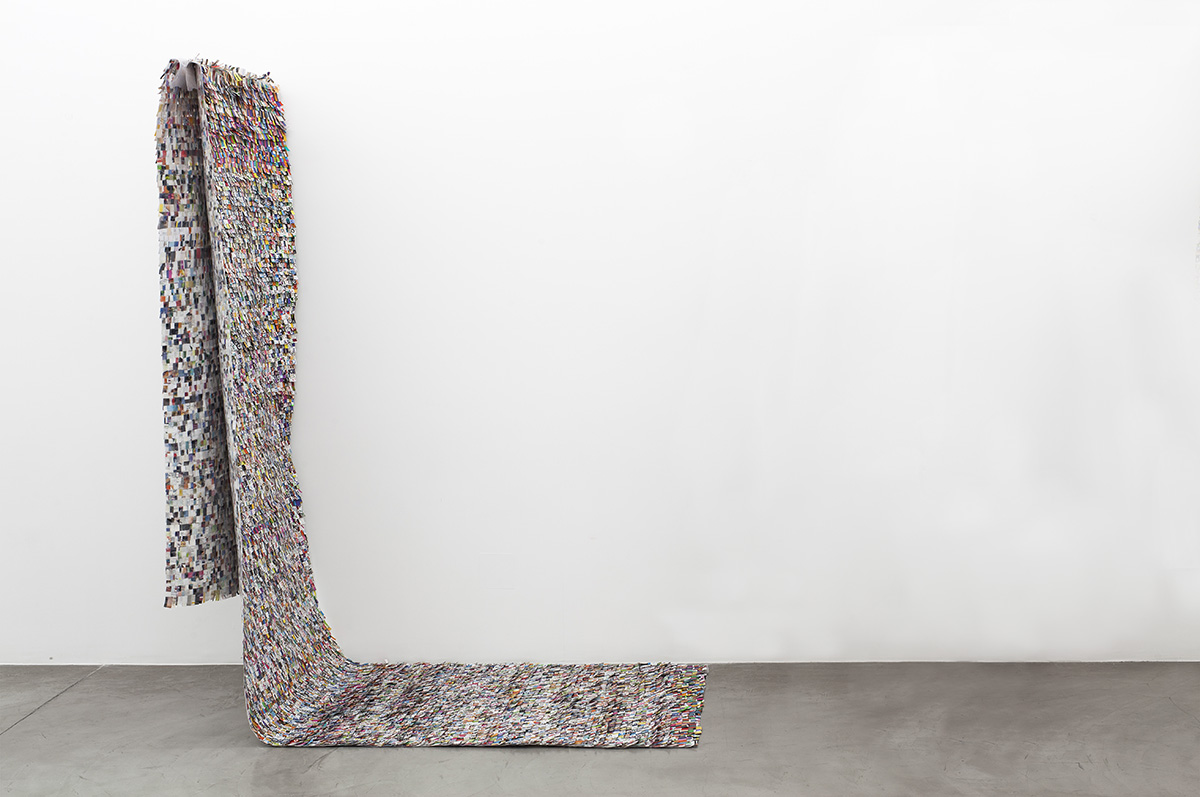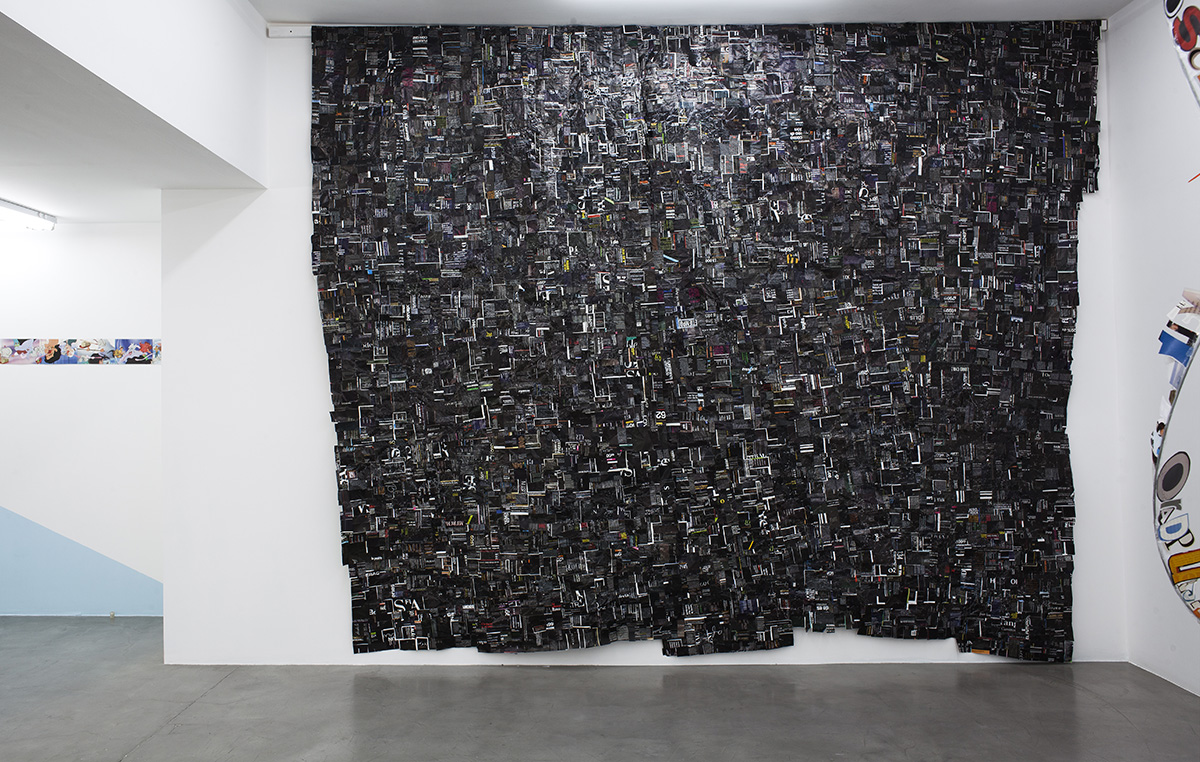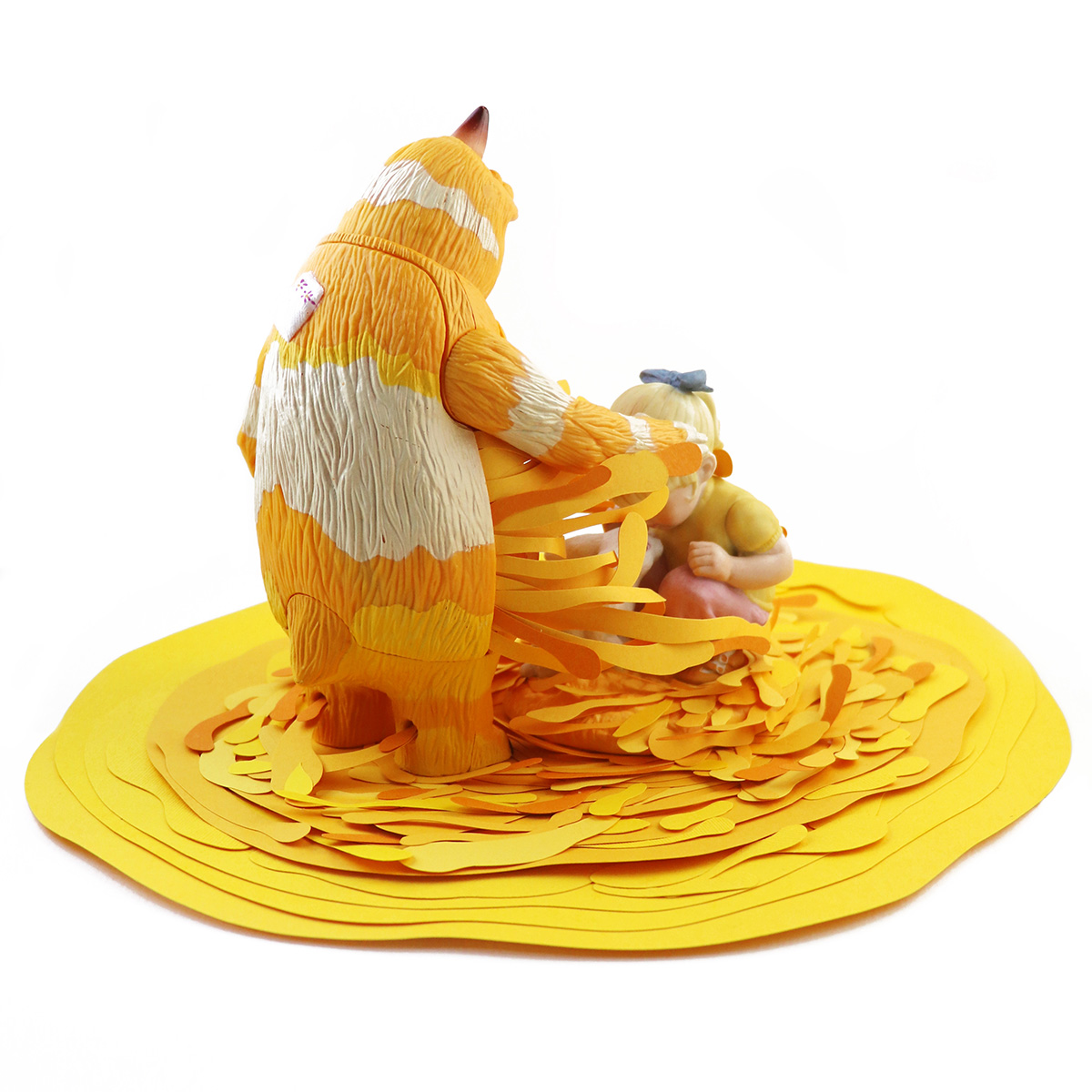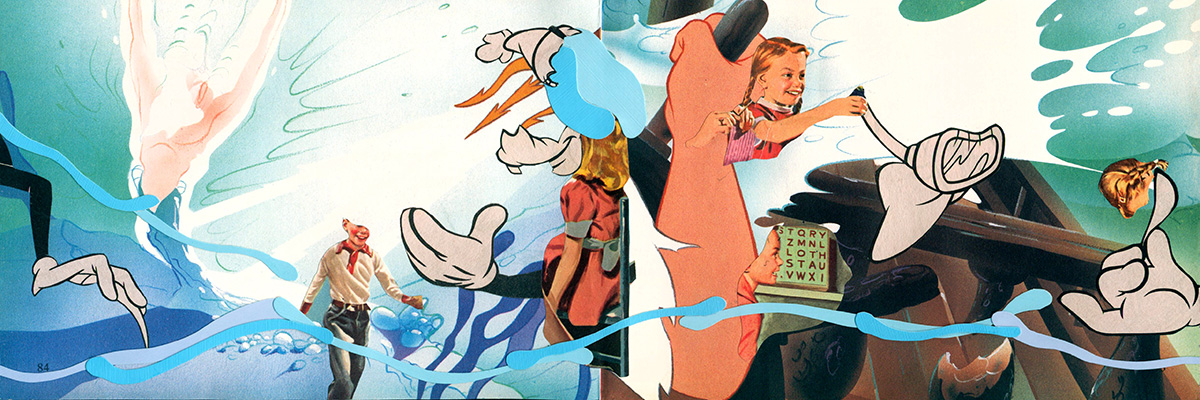ORDEN Y SECRETO
CATALINA SCHLIEBENER & DANI UMPI
CURATED BY Nicolás Cuello
AUG 13. — SEP 21. 2019
EXHIBITION VIEW
Ph. Ignacio Iasparra
works
Apuntes de las primeras 8 clases: Teoría Mística en Curso de Iniciación para Duendes vocacionales, 2019
Dani Umpi
Collage, paper, nylon & tulle
196.9 x 37.4 in (approximate measurements)
Blanco y negro, 2019
Dani Umpi
Magazine paper collage & tape
118.1 x 125.9 in (approximate measurements)
Paisaje, 2019
Dani Umpi
Installation
Paper collage on colored soaps
3.9 x 59.1 x 5.5 in (approximate measurements)
Hoguera, 2019
Dani Umpi
Installation
Toothpaste boxes and paper cones
59.1 x 27.5 x 23.6 in (approximate measurements)
Inside Out (Bim Bom). Series Satanic Panic, 2019
Catalina Schliebener
Installation
Porcelain figurine, articulated plastic figures, paper, light box
27.6 x 16.1 x 16.1 in
Version 1 of 2
Monster Inc. (George). Series Satanic Panic, 2019
Catalina Schliebener
Installation
Porcelain figurine, articulated plastic figures, paper, light box
27.6 x 16.1 x 16.1 in
Version 1 of 2
Monster Inc. (Sulley). Series Satanic Panic, 2019
Catalina Schliebener
Installation
Porcelain figurine, articulated plastic figures, paper, light box
27.6 x 16.1 x 16.1 in
Version 1 of 2
Prosthetic Blocks, 2019
Catalina Schliebener
Installation
Porcelain figurines, found objects
10.6 x 39.4 x 216.5 in (approximate measurements)
Little Mermaid. Series Satanic Panic, 2019
Catalina Schliebener
Collage on book pages
5.5 x 1078.3 in
text
by Nicolás Cuello
1.
Brazilian television show host, model, and actress Maria da Craca Meneghel, known internationally as Xuxa, was the protagonist of Brazilian entertainment’s greatest commercial success of the mid-eighties: her TV program “Xou da Xuxa” [The Xuxa Show], a product for children viewers, consisted of contests, musical numbers, and cartoons. It was aired every morning on Globo TV throughout the early nineties. Xuxa rapidly became a cultural icon not only in her native country but in other countries in the region as well (Mexico, Argentina, and Chile, for instance). Over the course of decades, Xuxa tirelessly produced feature films for children and a great many LPs that broke all records for a female children’s music artist. For that reason, in 1990, she was invited to the prestigious Viña del Mar International Song Festival in Chile. Even today, her presence there is remembered as a major cultural event and media phenomenon because of the number of people who came out to see her. Her visit, however, was not without controversy. While the country was paralyzed by the raucous enthusiasm occasioned by her arrival, a small radio station in Antofagasta, a small city in northern Chile, aired a story that would affect her future career as an entertainer: Félix Acori Gomez, a DJ at Antofagasta’s Radio Nacional at the time, was playing the artist’s first album named, like the artist herself, Xuxa and released in 1989. The cassette had accidently gotten jammed and, when he rushed to turn it over he heard a hidden message: “The devil is wonderful!” The radio station, undaunted by the legal reprisals that making such a discovery public might occasion, issued an alarming cry, unleashing a phantasmagoric suspicion that lives on today—The Queen of the Little Ones is diabolic!
Though there was never a resounding consensus on the authenticity of the spectral apparition in the song “Danza de Xuxa,” the story was explosive in the career of an artist at her peak. The controversy surrounding its legitimacy embroiled paranoid relatives, virulent media repudiations, surreal defamations, as well as public gatherings where her cassettes, along with any merchandise bearing the image of one now viewed as a fanatical servant of satan, were set fire. Though her show’s second season was a success, everything she did was now subject to constant religious scrutiny. The purity of her gleaming innocence was turned into a perverse stain. The clergy reinterpreted her every action, the symbols on her sets, the lyrics of her songs. The snakes, spiders, rats, and frogs in her contests were seen
as a cast of a demonic beasts. But that was not all. The shock these rumors incited only intensified when a production assistant on her latest show told the media he had seen her engaging in black magic, voodoo, and occult ceremonies backstage. And, as if that weren’t enough, he claimed to have heard from a reliable source that she donated blood twice a year to the Church of Satan in San Francisco. Furthermore, her name came from the combination of the names of two Umbanda “demons,” “O-xu” and “Ori-xa.”
The cultural phenomenon that acted on Xuxa in the nineties was part of what is known in the mass media in the United States as backmasking. The term originally referred to the process by which an audio cassette revealed hidden messages when played backwards. It is also used to refer to how certain religious groups—mostly Evangelicals and other Christians—induced widespread panic when they found hints of what they saw as an underground propensity toward Satanism in popular culture.
The genealogy of this paranoid passion dates back to the late seventies, when a vast array of disparate experiences consolidated as the widespread belief in the existence of demons, the possibility of being involuntarily possessed, demonic manifestations, and paranormal activities. These beliefs stemmed from the terrifying resonance of the Manson Family’s ritual killings in 1969, the publication of Anton LaVey’s The Satanic Bible that same year, the creation of the Church of Satan in 1966, the cultural impact of the publication of William Peter Blatty’s The Exorcist in 1972, followed by the release of its film version in 1973, and rising media fascination with two seemingly complementary figures: serial killers and evil nannies. While music was the realm in which the apparition of these sinister and foul voices was most widely reported—the lawsuit brought against the heavy metal band Judas Priest in 1985 being an exemplary case—religious groups also took notice of other forms of popular entertainment, particularly those intended for children: the film The Care Bears (1985) was condemned for featuring an evil spirit, and role-playing games like Dungeons and Dragons (1974), considered dangerous because of their dystopian epics, erotic representations of elves, and tentacle-bearing monstrosities.
For over two decades, public opinion was marked by hysteria: occult sciences were stigmatized, religious difference criminalized in the media, and political repression of popular culture increased during the Reagan administration. Driving this public desperation was an urgent need to protect the nuclear family from the dangers posed by the unknown other, an other historically dreaded for and often unjustly accused of targeting and corrupting children, always represented as fragile. This was ripe terrain for the rotten seed of the occult—the other that many believed could engage in creative forms of dark manipulation, inducing premature and deviant sexual desire in the most innocent among us.
In Orden y Secreto, Catalina Schliebener (1980) shows work that dwells, in innovative fashion, on just this point. The series Satanic Panic makes direct reference to this cultural phenomenon. It unfolds before us, an installation of sculptural objects that represent, in different ways, three scenes in which children, enraptured by their imaginations, are surrounded by what might look at first like threatening monstrosities. The scenes, dense due to shadows cast by cold lighting from below and strange due to the organic fluttering of the monochrome papers that make up their bases, situate us in a potentially critical moment: we assume we are trapped in the exact instant when those children are, it would seem, being attacked. We are teetering uncomfortably as witnesses to a horrific act where what’s at stake is the fragile integrity of an innocent body. We react duly; ours is an ethical response driven by a sense of justice. But the speed of that reaction and its obliqueness also naturalize an economic-moral order in which the nearness of children to any possible form of difference is constituted as threat. But as soon as we take a closer look at these plastic-haired beasts we see the tenderness of their gestures; we shift from a perspective mediated by the suffocating paranoia of a culture built on an always-renewable register of punitive fictions to a relational ethic based on affect that asks us if that which we consider a blow might not instead be an expression of care.
One of the cruelest aspects of the cultural phenomenon of satanic panic, and the one most telling about its origin in the post-Cold War period, was its perpetual search for hidden enemies. This mechanism of political surveillance interjected into the popular consciousness created a system of constant suspicion of anything that might destabilize the silent pact that reproduces the normal. From the red scare and racist imperialism to the sex wars and the demonization of HIV, the history of the United States has been characterized by the obsessive creation of demonized figures. Their destruction is an emotional glue that holds together a culture based on violence, looting, and supremacist ambition. The industrialized production of fear in Latin America was not an exception or an empty parallel to discussions in the Global North. The processes of democratic reconstitution in Latin America in the eighties took place, with different degrees of intensity, in social atmospheres eager for cultural openness but incapable of taking responsibility for the repressive remains of a society educated under ideological terror, political construction of the exterminable other, and insidious suspicion of any strange image that might endanger social reproduction. The restoration of individual freedoms, the occupation of the public space, and the availability of international cultural goods was cause for a certain discomfort among the conservative forces latent in the spring of the region’s new democracies. Those forces demonized every
pop-culture image that, for any reason, mobilized sensibilities or meanings in the register of the body, in traditional gender roles, or in sexual practices that run counter to the social pact.
By employing the strategy of critically appropriating Disney characters and including fragments of vintage illustrations from children’s books as well as found decorative objects, Schliebener continues a longstanding project focused on the enigmatic meanings of childhood, especially the languages in which children express, embody, and act out the perceptive potency of their strangeness. In earlier works, like Growing Sideways (Hache Galería, 2017), the technique of collage is the central tool used to explore the sideway movements that mark queer childhoods, establishing mad strands of combined meanings that work to create social signification. That earlier work troubled both the regimes of biopolitical assignation through the potency of human-animal assemblage and the strategic modification of bodies through the perverse use of pieces of characters from children’s popular culture. In Orden y Secreto, work that employs those same operations invites us to grapple less with how children can stray from an orientation imposed by the demand of the normal than with the forms of contact they establish with disoriented others, continuing a twisted legacy capable of producing precarious forms of kinship and belonging.
The ambivalent delicacy with which Schliebener deploys these strategies on to pop-culture images upsets the moral regime of threat that can easily be used to represent the ties between queer childhood and the wider world, as well as the ways that the queer is signified when in the proximity of childhood. This is a central discussion within the etymological history of that stigma we embrace as a name—queer: a criminal element, an intoxicating mark, a diseased density that ultimately deprives us, isolates us, divides us, pushes us into an existence with no world. How does a body that refuses to be straightened grow? From what histories does the possibility of its future spring? What do we have to
forget to be able to belong? If there is something queer in all childhoods and something childish in all queer experience, it is likely because of the affective continuity that produces the fragility of our experiences as a quality of the precarious relationship we establish with the world. An odd connection that shapes the arbitrary conditions imposed by sexual desires, gender experiences, and perceptive registers of the normal that silently instill themselves as natural—this is what the story of The Little Mermaid shows us. The artist uses this cultural text as the support for a profuse collage where countless children lose their old-fashioned features as, smiling, they flow, jump over obstacles, shout in a dark
language, turn into beasts, and run, coming apart slowly, within the scripted expectations of adulthood. Like Ariel (the protagonist of the film), they are forced to transform themselves, losing their voice to enter into an opaque prism of affective safety that is anything but safe.
The effects of gay assimilation, in particular the affective consequences of the institutionalized rhetoric of gay pride, has left little room for the public articulation of languages that show the ongoing history of the precariousness of queer experiences. The intrinsic connections between the queer and fragility are denied, as Sara Ahmed points out; she recognizes the genealogical centrality of weakness in the agency driving minority desires. That fragility has little to do with the representation, wrapped up in victimhood, of a defective body per se. It is tied, rather, to the political sensation that characterizes a life that finds itself exposed to a world where its language is inaudible, its body indecipherable, its
desires dangerous, and its sex a curse.
2.
For Ahmed, fragility as a queer experience of the body is bound to something else as well, another intrinsic meaning that makes itself felt in Orden y Secreto, especially in the work of Dani Umpi (1974): disorientation. We are speaking of the affect-effect produced by exhaustion, by the deterioration of a world that originally makes us fragile, i.e. that systematically reduces our ability to be imaginable, concealing our images and attempts to rectify, to straighten our languages. Ahmed admits that disorientation as bodily sensation can, in fact, be destructive; it can shatter our trust in the ground, our belief that the ground on which we stand can bear the actions that make a life livable. But she also sees moments of disorientation as vital experiences of intensity that shake up the world, pushing us outside the straight lines that organize the regime of the sensory, of the known, of the desirable. When it loses the grounding it needs, a body may be or feel lost, destroyed or off-kilter. But in that perceptive change that confounds us, in that flow that produces
disorientation, we can find new grounding, other hands to grasp onto. We can, then, drift towards encounters with other bodies, strange bodies in which to find possibilities, with which to construct kinship lines and to communicate obliquely.
On that basis, I would venture that another characteristic fundamental to the queer experience is its continuity as a system of expressive invention. A creativeness that blossoms not as substance, but as antagonistic practice in response to the symbolic suffocation of straight imagination, where the demand for transparency, meaning and sense,
coherence and cognitive rectitude reigns. We might think that what is at stake in that which we call queer is the strategic counter-production of the existential wilderness that produces fragility in oblique languages, twisted references, occult sciences, clandestine dialects, underground imaginaries that historically and indirectly have found gaps in which to lead
uncomfortably pleasurable lives. An alchemic process that turns the silent existence of a tentative desire into a critical language that attempts to become common language by empowering the promise of the odd.
In 1977, artist, photographer, and art critic Hal Fischer produced the photo-book Gay Semiotics. It was an investigation of the communal use of the “hanky code,” a sexual recognition system based on the use of different color bandanas in gay communities in the Castro in San Francisco. Also known as flagging, this practice entails the creation of non-verbal communication to indicate the type of sexual practice its bearer is interested in. The bandana, an American accessory typical of cowboys and laborers, machinists and sailors, is thus appropriated. In a back pocket, around an arm or neck, the bandana could be coded publicly; its color and position on the body indicated the fetish or sexual role preferred by the homosexual wearing it during sex. It is believed that the hanky code began during the California Gold Rush (1848-1855), when communities of mostly male migrant workers developed other forms of affectation amongst themselves, clandestinely deregulating the harsh fences of heterosexuality as fate.
Informed by the cultural impact of structuralism and the drive to identify power’s productive mechanisms, which underlie any form of social communication, Fischer set out to analyze the differential marks of the homosexual body in an explosive period like the seventies. His portraits, which replicate the forms of representation found in fashion magazines, reformulated the meanings of wearing leather garments, certain keychains and chains, rings, handkerchiefs, earrings, and many other accessories. While the analytic dissection of the “gay looks” of the period did not capture the community in its entirety, it did attest to the bodily languages of some possible incarnations of homosexual desire. Initially a series of large photographs, Fischer’s work was later compiled in a book put out by NFS Press. The project was an (incomplete) semiotic study of a specific period and the queer lives lived in it. Mostly, though, it was an ingenious approach to the way that signs—the deviated appropriations, perverse trafficking, and diagonal circulation of them—can form silent structures of sociability based on the unruly forces of a desire denied.
With these references in mind, I would like to return to disorientation as queer experience capable of inventing common imaginaries at the cusp of the world. Languages that, in most cases, must remain under the shroud of secrecy since the order they propose on the real upsets reproductive normality as imperative for social continuity. This is the case with Duendadas (Elf Tricks), a series of collages in which Dani Umpi puts together unintelligible fragments of an underground imaginary constructed by clipping and deconstructing print ads in popular magazines. In these pieces, we are immersed in the strange confusion of a system of relations, visual hierarchies, psychic associations, and conjured desires that, thanks to their cryptic luminosity, flee obligatory meaning. We are riveted by a mysterious message in which these tiny fantastic beings whisper novel assemblages. They do so by inverting the given, and rendering capitalist magic counterproductive. If there is one thing that defines a universal history of sects and secret societies, it is not their origin as responses to certain social conditions, but their desire to give rise to a new order, a new society, whose hidden methods are condensed as magical or totemic characters. Thus, the harmless and cheerful figure of the elf in Orden y Secreto stirs, in Umpi’s work, the delicate danger that springs from the playful twisting of language and its commercialized horizons, to find a daring pleasure both in the clandestine nature of its meanings and in the threatening transmission of alternative signifiers, images, and theories.
In a quick genealogy that brings together stereotyped characters like the bruja partera (the midwife-witch), the striking teacher, the overblown columnist, and the diabolic feminist, Umpi becomes something of an educator, an impossible translator of other knowledges, of foreign languages and muddled desires. He does so by undermining, or by tackling cheerfully, the devalorization of feminized procedures like handicrafts to take on the humble task of conveying small stories, forms of magic knowledge, and strange alliances that invite us to listen to the silent power of difference in order to communicate desire through ambiguity and misunderstanding through the signifiers of popular culture. In Apuntes de duende (Elf Notes)—another series of large-scale collages created using a method of obsessive writing that recurs in Dani Umpi’s work, one in which texts blossom from small clippings of, among other things, full colors and different typefaces—Umpi introduces, opaquely, the cultural life of elves, as if notes from a class in which these fantastic beings learn their own history: their mysticism, art, friendship, and self-actualization as subjects of
magical politics.
This fascination with small cultures as cultural systems that link fantasy and antagonism is not surprising. Historically, the lives of elves, gnomes, and other small-bodied magical beings have been powerful points of reference for conspiratorial direct-action movements leveled against the dominant sensibility. Think of the Kabouters (gnomes), for instance, a Dutch anarchist group that was one of the most important counter-cultural forces in Europe in the seventies. They formed alternative anti-capitalist communities based on an ethic of fair trade, a critique of technological advancement, a defense of cannabis consumption, and an environmental awareness. Members of the gnome movement occupied buildings and abandoned houses to form cultural centers in which to spread the word of the movement’s
founder, Roel van Dujin, author of the mythical book The Message of a Wise Kabouter (1972). That book inspired a large sector of young people to put into practice a critique of the State by means of pacifist actions that ranged from large happenings to street performances that used absurd humor indebted to Dada. Van Dujin, who worked for a time on an organic farm, proposed the image of the gnome as the central figure because he recalled how the farmer who employed him resisted buying industrial harvesters because “noisy machines chase away the kabouters [gnomes], and we need them to keep our plants healthy.”
For some time, Umpi’s work has envisioned the elf not as an empty fetish, but as a being that mobilizes creative exercises of listening. The elf as figure of twisted legibility was present—it’s true—in the artist’s last show, Maldito duende (Damned Elf, Hache Galería, 2017), but it acts more broadly in his work as a sort of ongoing question. This time, the elf resonates in Ley (Law), an analog transcription of the secret messages that Aleister Crowley received from the divine entity Aiwass while in Cairo in 1904, expressed today in the ambiguous Thelema, The Book of the Law. This family of fantastic beings is not only a source of formal inspiration rich in the imaginary of childhood, but also a set of agents from whom to learn another ethic capable of throwing off the straight lines of a hyper-productive sensibility that structures the possible.
3.
On the occasion of a partial Andy Warhol retrospective in Argentina (Malba, 2009), researcher Ana Longoni wonders, in her text “¿Afinidades pop?” to what extent it is possible to imagine decentered narratives of the ties between experimental art and popular culture in Latin America. More specifically, can that be done without falling into a derivative
logic that naturalizes the colonial era center-periphery power relations that read those Latin American productions as mere repercussions, as forms of appropriation or as quotes of the languages of the Global North. She thus proposes a “skewed reading” of initiatives that propose other possible combinations of art, mass media, and printing techniques like silkscreen, combinations that attest to a wide range of experiences constituted not as a Pop counter-canon but as interferences in Pop’s conditions of legibility and processes of legitimation.
The critical exercise proposed by Longoni furthers the debate on Pop art in Latin America by looking back to Oscar Masotta and his publication El “pop art” (1967). In this published series of lectures given at the Instituto Di Tella in 1965, the theorist formulated a novel approach to an art form seen as an unprecedented break from what had come before. In his theses, Masotta ties the historical emergence of Pop sensibility to the then-contemporary eruption of semantics, semiology, and other critical studies of language. In his view, Pop art is able, through operations like fragmentation, partiality, and repetition, to relegate form in order to accentuate instead its observation in material consciousness, that is, in the signs themselves. His general thesis is that Pop art is an art of the object masked by languages, an art whose theme is not things, but the signifying “atmospheres” that produce them. And, as Ana Longoni points out, Masotta, unlike Pop art’s detractors who believed it was an exaltation of consumer society, recognized that it could potentially de-alienate insofar as commentary on processes in which a society naturalizes its own social structure.
I would like to salvage that critical function of Pop art to grapple with how, in Orden y Secreto, Catalina Schliebener and Dani Umpi devise similar strategies. In their work, experimentation with imaginaries that fluctuate between the innocence of childhood and the perilousness of the occult in popular culture, which, by means of the delicate procedures associated with the feminization of handicrafts, reveals the intrinsic mechanism by which a society naturalizes a straight order, of body, sex, and desire. The operations of dis-assemblage that both artists perform on items of graphic culture (clippings from entertainment magazines and children’s stories, for instance) lay out a practical theory of queer fragilization of language, its politics of contagion, and its community effects. That theory, and the negative responses to it, reveals the sexed matrices of power that organize the economy of the visible. If, for Ana Longoni, this decentered approach to Pop sheds light on the value of artistic practices that used its experimental approach to mass sensibility to act on processes of social transformation, I would like to use the resonances of that strategy to envision how the queer, insofar as a means to (un)make popular culture, can speak to the ways art can interrogate not only the structural condition of signs, but also the systems of sexuation that order their productivity. That disoriented approach to Pop art, then, allows us to question the sexed nature of the language of mass culture both as structure of meaning and, indeed mostly, as a politics of desiring orientation that organizes the institutionalization
of the acceptable, the clandestineness of the different, the proximity of the necessary, and the necessary distancing of the accessory, the occult, the unproductive, i.e. everything that can be called a dangerous deviation, a fantasy with no name, or an oblique body. Orden y Secreto, then, turns the fragility of small worlds into labyrinths in which to fool the legacy of sense in order to finally enjoy that amusing promise called freedom.
ARTISTs
Dani Umpi
CATALINA SCHLIEBENER
